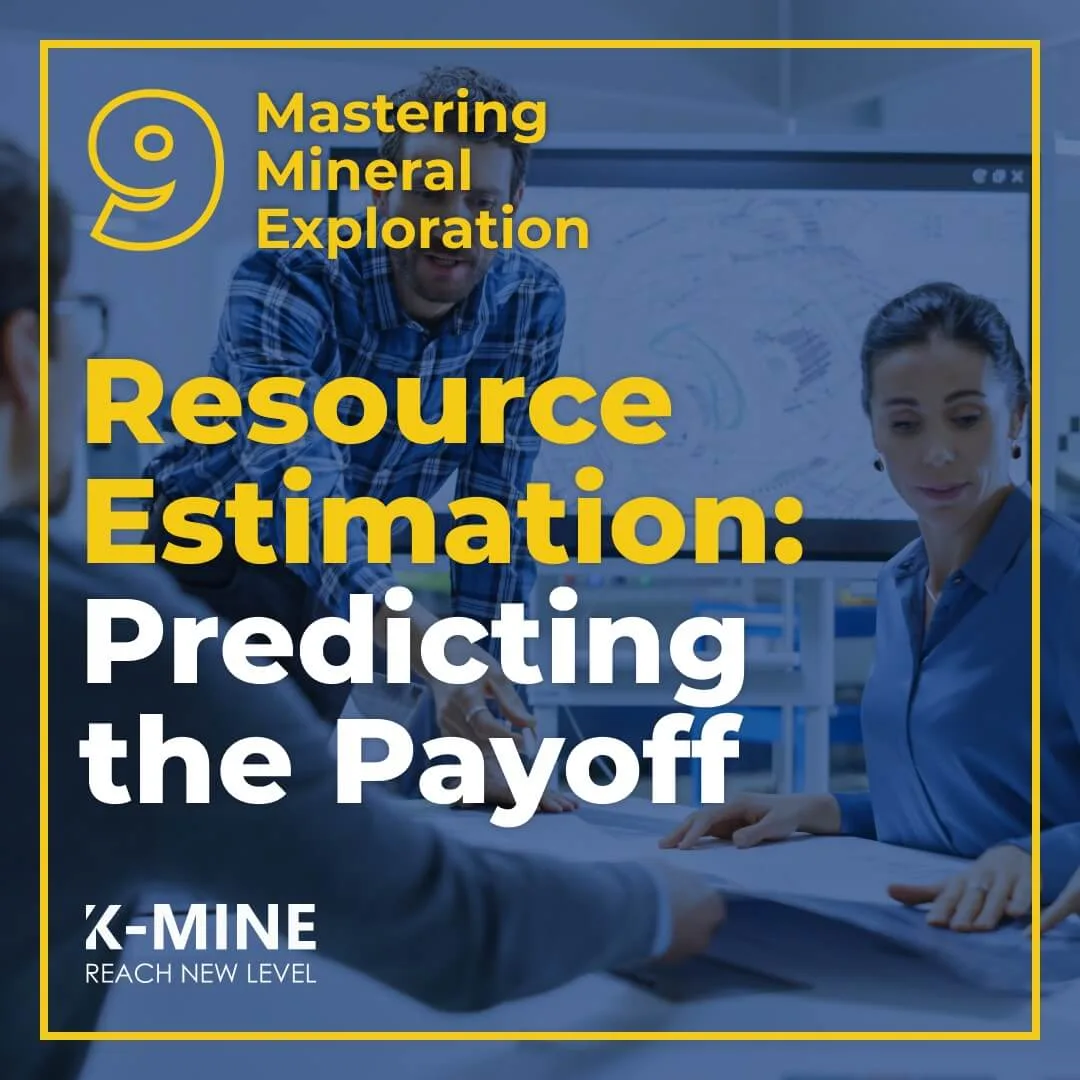
Content
In the realm of mineral exploration, resource estimation is a vital process that dictates the economic viability of prospective deposits. It is the quantitative assessment that helps mining companies answer the essential question: How much is there, and is it economically extractable?
Resource estimation is the juncture where exploration transitions into potential economic reality. It’s the science and art of predicting the quantity and grade of mineral deposits, usually expressed in tonnes and grams per tonne for metals, or in carats per tonne for diamonds. It involves calculating the volume of the mineralized body and the concentration of the minerals within, leveraging the vast amounts of geospatial data gathered during the exploration phase.
This meticulous process is pivotal as it significantly influences investment decisions, dictates the direction of potential mining operations, and impacts the overall profitability of a mining project. Consequently, it needs to be performed with the utmost precision, rigor, and understanding of the mineral deposit’s intricacies. This article aims to unpack the fascinating process of resource estimation, guiding you through its significance, methods, and challenges in the world of mineral exploration.
What is Resource Estimation?
Resource estimation, also known as mineral resource estimation, is a crucial component of the mining lifecycle that bridges the gap between mineral exploration and mine planning. At its core, it’s the practice of determining and expressing the amount and quality, or ‘grade’, of minerals that are present in a given geological deposit. The objective is to create a reliable representation of the deposit that can guide potential mining operations and investment decisions.
The estimation process begins with the geospatial data collected during exploration, encompassing drill hole data, geochemical assays, geophysical data, and more. The data, once appropriately processed, are used to construct a geological model, representing the physical characteristics, mineralization, and boundaries of the deposit. Following this, geostatistical methods, like kriging, are used to estimate the grade of the mineral throughout the deposit based on the collected samples.
Resource estimation’s importance in mining cannot be overstated. It is an essential decision-making tool in the mining industry, driving investment decisions and determining whether a mining project is economically feasible. Misestimations can lead to expensive mistakes, such as overvaluation of a project, or missed opportunities in the case of undervaluation. Therefore, the reliability and accuracy of resource estimates are of paramount importance to mining companies and their investors.
Types of Mineral Resources and Reserves
The classification of mineral resources and reserves is an important part of resource estimation. It provides a standard way to communicate the level of confidence in the estimate to stakeholders, including investors, regulators, and the public. The terminology can vary somewhat depending on the specific reporting code in use (such as the JORC Code, SAMREC Code, or NI 43-101), but the underlying principles are largely consistent across the industry.
The first broad category is Mineral Resources, which are those mineral concentrations with reasonable prospects for eventual economic extraction.
They’re subdivided into three categories based on the level of geological confidence:
- Inferred Mineral Resource: This is the lowest level of confidence, based on limited geological evidence. It’s speculative in nature and must be used with caution. The location, quantity, grade, continuity, and other geological characteristics are inferred from geological evidence and assumed but not verified.
- Indicated Mineral Resource: This category requires sufficient data to assume but not verify geological and grade continuity. It’s used in the application of Modifying Factors to support mine planning.
- Measured Mineral Resource: The highest level of geological confidence, this category requires sufficient data to confirm geological and grade continuity. The location, quantity, grade, continuity, and other geological characteristics are known, estimated, or interpreted from specific geological evidence and knowledge.
The second broad category is Mineral Reserves, which are resources known to be economically feasible to extract.
They are also subdivided into two categories:
- Probable Mineral Reserve: This has lower confidence than the Proven category. It includes either Measured or Indicated Mineral Resources, and the Modifying Factors have been applied.
- Proven Mineral Reserve: This is the highest level of confidence category of reserve. It includes only Measured Mineral Resources, and the Modifying Factors have been applied.
As we move from Inferred to Proven categories, the level of geological confidence increases, and thus the risk decreases. It’s important to note that the conversion of resources to reserves is not merely a technical process, but it requires consideration of economic, mining, metallurgical, legal, environmental, social, and governmental factors (known as Modifying Factors).
Data Requirements for Resource Estimation
Resource estimation is a critical phase in mineral exploration, and its accuracy significantly hinges on the quality and completeness of the data used. To create a comprehensive and reliable estimation, various types of data collected during the exploration phase are needed, each adding their unique piece to the puzzle.
- Geological Data: Geological data forms the backbone of resource estimation. It provides essential information about the types of rocks, the structure of the deposit, and the geological processes that have affected it. This data is primarily obtained from field mapping, core drilling, and logging activities. Geological data helps to understand the deposit’s morphology, the mineralization style, and continuity, which are fundamental aspects in building a geological model.
- Geochemical Data: Geochemical data provides insights into the concentration of different elements and minerals within the deposit. It includes assay data from rock, soil, and drill samples. It is crucial in determining the grade of the mineralization, which, combined with the volume of the deposit determined from geological data, allows the calculation of the total metal content.
- Geophysical Data: Geophysical data aids in understanding the deposit’s spatial characteristics, such as its depth, size, and shape. Geophysical methods involve measuring variations in physical properties like magnetism, gravity, electrical conductivity, and natural radiation, both at the surface and down the drill holes. This data can be used to infer the subsurface geology and identify mineralized zones that could be targets for drilling.
- Metallurgical Data: Metallurgical testing data is essential for understanding how the ore will behave in a processing plant and what recovery rates can be expected. This helps in determining the portion of the mineral resource that can be classified as a reserve, i.e., economically extractable.
The quality and integrity of these data are paramount. Errors or inconsistencies in data can lead to incorrect estimations, which can result in costly mistakes down the line. Therefore, best practices in data collection, management, and validation are fundamental to ensuring reliable resource estimation.
Resource Estimation Methods
Resource estimation methods serve to estimate the grade and tonnage of a mineral deposit. These methods are based on mathematical models that make use of the exploration data collected.
Let’s look at some of the commonly used resource estimation methods:
- Polygonal Method: This is one of the simplest methods of resource estimation. Each sample point is assigned an area of influence, and the average grade within each polygon is assumed to be the grade of the sample point. This method works best for deposits with a regular shape and closely spaced sampling.
- Triangular Method: This method, also known as Triangulation, involves drawing triangles between nearest sample points. The grade of each triangle is taken as the average of the grades at its three vertices. The volume of the triangle is then multiplied by its grade to calculate the total mineral content. This method provides more detailed modeling compared to the polygonal method, but it is still quite simplistic.
- Inverse Distance Weighting (IDW): IDW is a more advanced method that assigns weights to sample points based on their distance to the estimation point. The basic premise is that points closer to the estimation location will have more influence on the estimated grade than points farther away. This method can model spatial changes more accurately than the polygonal or triangular methods.
- Kriging: Kriging is a sophisticated statistical technique that not only considers the distance between sample points and the estimation point but also takes into account the spatial correlation between sample points, which is modeled using variograms. Kriging provides the best unbiased estimate and also quantifies the estimation error, which is essential for resource classification. Kriging is currently the most widely used method in resource estimation.
Each of these methods has its strengths and limitations, and the choice of method depends on the nature of the deposit, the spatial distribution of the sample points, and the level of detail required. These methods require a sound understanding of geostatistics and should be applied with care. They also require robust software tools to handle the complex calculations and visualizations involved.
From Resource to Reserve – The Role of Economics
Once a mineral resource has been estimated, the next step is to determine how much of it can be classified as a mineral reserve. This is where the economic feasibility of mining the deposit comes into play.
The role of economics: Not all parts of a mineral deposit are economically viable to mine. The decision to classify a portion of a resource as a reserve depends on several economic factors, including the current market prices for the mineral, the cost of extraction and processing, and the overall investment required to develop the mine. These factors form part of a feasibility study, which is an in-depth analysis of the technical, economic, legal, regulatory, and social aspects of a mining project. Only if the feasibility study shows a positive economic outcome, a portion of the mineral resource is upgraded to a mineral reserve.
The concept of cut-off grade: One of the critical factors in determining reserves is the concept of the cut-off grade. This is the minimum grade (i.e., the minimum concentration of the mineral in the ore) required for the mining operation to be economically viable. The cut-off grade depends on many factors, including the price of the mineral, mining and processing costs, and the recovery rate.
The cut-off grade plays a significant role in defining the shape and size of the orebody that will be mined. If the cut-off grade is set too high, a potentially economic portion of the resource might be left in the ground. If it’s set too low, the mining operation could end up processing uneconomic material, leading to financial losses. Therefore, determining the cut-off grade is a critical decision in the resource to reserve conversion process.
So, while resource estimation is about quantifying “what’s there” in the ground, the transition from resource to reserve is about defining “what’s worth mining.” Both processes are fundamental to the success of any mining project.
Software in Resource Estimation
Software tools have become an integral part of the resource estimation process, offering the ability to handle large volumes of data and perform complex calculations.
The role of software tools: Resource estimation involves analyzing extensive amounts of exploration data to predict the characteristics of a mineral deposit. It involves using statistical and geostatistical methods to estimate the grade and tonnage of the deposit. This process requires the handling of vast amounts of data and the use of complex mathematical models, which is where software tools come into play.
Software tools like K-MINE have been designed to facilitate the resource estimation process. They offer a range of features, including data management, statistical analysis, geostatistical modeling, and 3D visualization. These tools allow geologists and mining engineers to manage and analyze exploration data effectively, create accurate resource models, and estimate the volume and grade of mineral deposits with a high degree of confidence.
Economic evaluations: Beyond the estimation of resources, these software tools also offer capabilities for conducting economic evaluations. They allow users to input economic parameters such as commodity prices, mining and processing costs, and discount rates. These tools can then calculate the net present value (NPV), internal rate of return (IRR), and payback period of a mining project, assisting in the decision-making process.
In essence, software tools like K-MINE have made the complex process of resource estimation more efficient and reliable. They allow for a more in-depth understanding of the deposit, enable better decision-making, and ultimately, contribute to the successful development of mining projects.
Challenges in Resource Estimation
In resource estimation, geologists and mining engineers often face numerous challenges.
Here are a few key ones:
Spatial Variability: Mineral deposits are not uniformly distributed in the earth’s crust. They vary from place to place due to the natural processes that formed them. This spatial variability presents a significant challenge in resource estimation as it adds an element of uncertainty to the predicted volume and grade of the deposit.
Grade Distribution: Alongside spatial variability, the distribution of mineral grades within a deposit is another significant challenge. Some parts of the deposit may have high-grade mineralization, while others may have low-grade mineralization. Accurately predicting the grade distribution is crucial as it directly impacts the economic viability of the mining project.
Economic Factors: The economics of mineral extraction can significantly influence resource estimation. Factors such as commodity prices, extraction and processing costs, and regulatory requirements can change over time, impacting the cut-off grades and the classification of resources and reserves. The volatile nature of these factors adds another layer of complexity to resource estimation.
Estimation Method Limitations: Each resource estimation method comes with its own set of assumptions and limitations. For instance, the Polygonal Method assumes uniform grade between drill holes, which may not always hold true. On the other hand, geostatistical methods like kriging can be complex and require a deep understanding of statistical concepts. Choosing the right method that best represents the deposit and acknowledges its assumptions and limitations is a critical challenge.
Despite these challenges, geologists and mining engineers strive to provide the most accurate resource estimates possible. They use advanced software tools, adhere to industry best practices, and continually update their models with new data to improve their predictions. The goal is to reduce uncertainty and risk, enabling informed decision-making and successful mining projects.
The Future of Resource Estimation
As we step into the future, resource estimation in mineral exploration will undoubtedly continue to evolve, driven by advancements in technology, software, and methodologies.
Here are some key trends to watch out for:
Machine Learning and AI: With the advent of Machine Learning (ML) and Artificial Intelligence (AI), the mining industry is set to undergo a significant transformation. These technologies can handle large volumes of complex data and learn patterns that humans may miss. They hold promise in improving the accuracy of resource estimation by identifying patterns in geological data, predicting grade distribution, and quantifying uncertainty.
Real-Time Data Processing: Real-time data processing allows mining companies to make quicker and more informed decisions. In the context of resource estimation, this could mean near-instantaneous updates to resource models as new exploration data is collected. This will significantly reduce the time between data collection and decision-making.
Cloud-Based Platforms: Cloud technology is another trend that’s reshaping the mining industry. Cloud-based platforms offer greater data storage, scalability, and accessibility, enabling geologists and engineers to access and work on resource models from anywhere, fostering collaboration and efficiency.
3D and 4D Modelling: The use of advanced 3D and 4D modelling in resource estimation is on the rise. These models provide a more accurate representation of mineral deposits, taking into account the complexities of the geological structures. Moreover, 4D models, which include the time factor, can help in understanding the evolution of a deposit over time, enhancing predictive accuracy.
Integration of Multidisciplinary Data: Future resource estimation will likely witness a more integrated approach, where data from various disciplines (geology, geophysics, geochemistry, engineering, etc.) is used collectively to build more accurate resource models. This approach can offer a more comprehensive understanding of the deposit and its economic potential.
The future of resource estimation appears to be more precise, efficient, and informed. With these advancements, the mineral exploration industry will be better equipped to manage risks and make confident decisions about potential mining projects.
Conclusion
In conclusion, resource estimation is a fundamental process in mineral exploration, enabling companies to determine the economic feasibility of potential mining projects. It involves predicting the volume and grade of mineral deposits, which is crucial for making informed investment decisions.
We’ve journeyed through the core elements of resource estimation, understanding its purpose, the types of mineral resources and reserves, the necessary data requirements, the commonly used estimation methods, and the role of software tools in simplifying and enhancing the process.
Moreover, we’ve explored the inherent challenges in resource estimation, the various elements of uncertainty, and the importance of economic considerations in transitioning resources to reserves. Yet, as we’ve seen, the future holds promising developments with advances in technology, such as machine learning, AI, real-time data processing, cloud-based platforms, and advanced modelling techniques, all aimed at improving the accuracy and efficiency of resource estimation.
Stay tuned for the next article in our series where we’ll delve into the final steps of mineral exploration and the decision-making process. We’ll discuss the critical aspects that need to be evaluated before the decision to mine is made, ensuring our journey from concept to discovery is complete.



 Back
Back